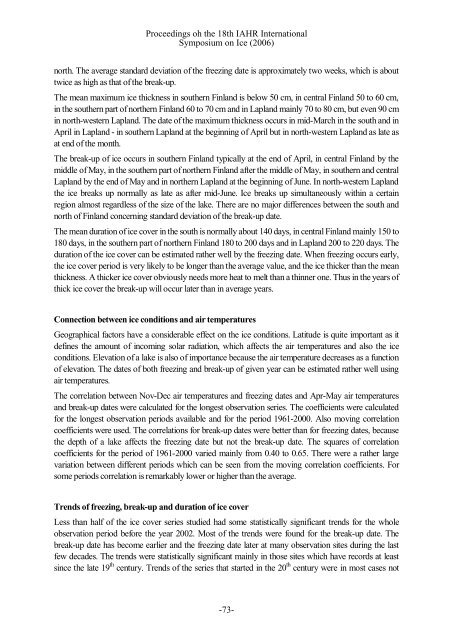LONG-TERM TRENDS IN LAKE ICE COVER IN FINLAND - River Ice
LONG-TERM TRENDS IN LAKE ICE COVER IN FINLAND - River Ice
LONG-TERM TRENDS IN LAKE ICE COVER IN FINLAND - River Ice
You also want an ePaper? Increase the reach of your titles
YUMPU automatically turns print PDFs into web optimized ePapers that Google loves.
Proceedings oh the 18th IAHR InternationalSymposium on <strong>Ice</strong> (2006)north. The average standard deviation of the freezing date is approximately two weeks, which is abouttwice as high as that of the breakup.The mean maximum ice thickness in southern Finland is below 50 cm, in central Finland 50 to 60 cm,in the southern part of northern Finland 60 to 70 cm and in Lapland mainly 70 to 80 cm, but even 90 cmin northwestern Lapland. The date of the maximum thickness occurs in midMarch in the south and inApril in Lapland in southern Lapland at the beginning of April but in northwestern Lapland as late asat end of the month.The breakup of ice occurs in southern Finland typically at the end of April, in central Finland by themiddle of May, in the southern part of northern Finland after the middle of May, in southern and centralLapland by the end of May and in northern Lapland at the beginning of June. In northwestern Laplandthe ice breaks up normally as late as after midJune. <strong>Ice</strong> breaks up simultaneously within a certainregion almost regardless of the size of the lake. There are no major differences between the south andnorth of Finland concerning standard deviation of the breakup date.The mean duration of ice cover in the south is normally about 140 days, in central Finland mainly 150 to180 days, in the southern part of northern Finland 180 to 200 days and in Lapland 200 to 220 days. Theduration of the ice cover can be estimated rather well by the freezing date. When freezing occurs early,the ice cover period is very likely to be longer than the average value, and the ice thicker than the meanthickness. A thicker ice cover obviously needs more heat to melt than a thinner one. Thus in the years ofthick ice cover the breakup will occur later than in average years.Connection between ice conditions and air temperaturesGeographical factors have a considerable effect on the ice conditions. Latitude is quite important as itdefines the amount of incoming solar radiation, which affects the air temperatures and also the iceconditions. Elevation of a lake is also of importance because the air temperature decreases as a functionof elevation. The dates of both freezing and breakup of given year can be estimated rather well usingair temperatures.The correlation between NovDec air temperatures and freezing dates and AprMay air temperaturesand breakup dates were calculated for the longest observation series. The coefficients were calculatedfor the longest observation periods available and for the period 19612000. Also moving correlationcoefficients were used. The correlations for breakup dates were better than for freezing dates, becausethe depth of a lake affects the freezing date but not the breakup date. The squares of correlationcoefficients for the period of 19612000 varied mainly from 0.40 to 0.65. There were a rather largevariation between different periods which can be seen from the moving correlation coefficients. Forsome periods correlation is remarkably lower or higher than the average.Trends of freezing, breakup and duration of ice coverLess than half of the ice cover series studied had some statistically significant trends for the wholeobservation period before the year 2002. Most of the trends were found for the breakup date. Thebreakup date has become earlier and the freezing date later at many observation sites during the lastfew decades. The trends were statistically significant mainly in those sites which have records at leastsince the late 19 th century. Trends of the series that started in the 20 th century were in most cases not-73-
















